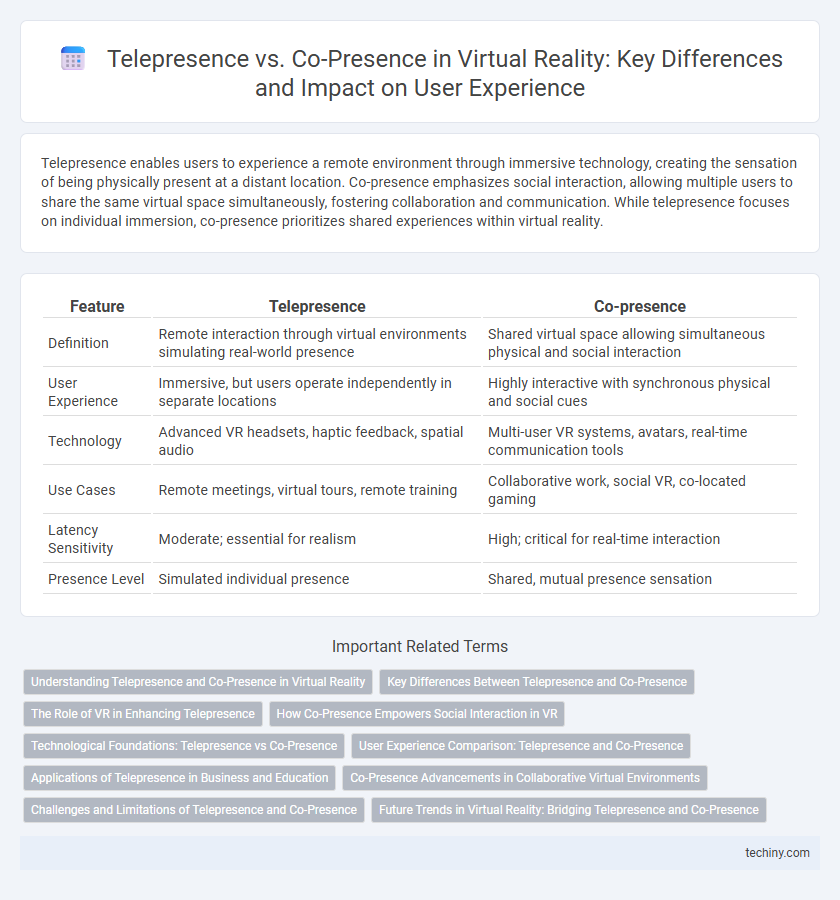Telepresence enables users to experience a remote environment through immersive technology, creating the sensation of being physically present at a distant location. Co-presence emphasizes social interaction, allowing multiple users to share the same virtual space simultaneously, fostering collaboration and communication. While telepresence focuses on individual immersion, co-presence prioritizes shared experiences within virtual reality.
Table of Comparison
| Feature | Telepresence | Co-presence |
|---|---|---|
| Definition | Remote interaction through virtual environments simulating real-world presence | Shared virtual space allowing simultaneous physical and social interaction |
| User Experience | Immersive, but users operate independently in separate locations | Highly interactive with synchronous physical and social cues |
| Technology | Advanced VR headsets, haptic feedback, spatial audio | Multi-user VR systems, avatars, real-time communication tools |
| Use Cases | Remote meetings, virtual tours, remote training | Collaborative work, social VR, co-located gaming |
| Latency Sensitivity | Moderate; essential for realism | High; critical for real-time interaction |
| Presence Level | Simulated individual presence | Shared, mutual presence sensation |
Understanding Telepresence and Co-Presence in Virtual Reality
Telepresence in virtual reality enables users to feel physically present in a remote environment through immersive sensory input, enhancing interaction with distant spaces or objects. Co-presence refers to the experience of shared presence, allowing multiple users to perceive each other as if they occupy the same virtual space simultaneously. Understanding these concepts is crucial for developing VR applications that foster realistic social interactions and collaborative environments.
Key Differences Between Telepresence and Co-Presence
Telepresence enables users to interact with a remote environment through immersive VR technology, creating a sense of physical presence from a distance. Co-presence refers to multiple users sharing the same virtual space simultaneously, facilitating real-time social interaction and collaboration. Key differences lie in telepresence prioritizing individual immersion in remote settings, whereas co-presence emphasizes simultaneous group engagement within shared virtual environments.
The Role of VR in Enhancing Telepresence
Virtual Reality (VR) significantly enhances telepresence by creating immersive environments that enable users to interact as if physically present despite geographical distances. This heightened sense of presence surpasses traditional video communication by simulating sensory inputs and spatial awareness, promoting more natural and intuitive interactions. VR's ability to replicate real-world co-presence dynamics facilitates collaboration, social bonding, and engagement in remote contexts, transforming how people connect and communicate digitally.
How Co-Presence Empowers Social Interaction in VR
Co-presence in virtual reality creates a shared spatial environment where users perceive each other's presence in real-time, enhancing social cues like gestures and eye contact. This immersive social interaction fosters stronger emotional connections and collaboration compared to telepresence, which mainly transmits limited sensory information. VR platforms leveraging co-presence technology enable more natural communication, improving teamwork, learning, and entertainment experiences.
Technological Foundations: Telepresence vs Co-Presence
Telepresence technology relies on advanced sensory input and feedback systems, such as high-resolution displays, spatial audio, and haptic devices, to create an immersive remote experience that simulates physical presence across distances. Co-presence emphasizes synchronous interaction within shared virtual environments, leveraging real-time motion tracking, gesture recognition, and low-latency network protocols to facilitate natural social communication among participants. Both paradigms depend on cutting-edge technologies like VR headsets, 5G connectivity, and AI-driven avatars to enhance user engagement and replicate human presence in digital spaces.
User Experience Comparison: Telepresence and Co-Presence
Telepresence delivers a user experience centered on immersive interaction with remote environments, leveraging high-fidelity audio-visual cues to simulate physical presence. Co-presence emphasizes synchronous social engagement, allowing users to perceive shared spatial awareness and real-time non-verbal communication within virtual spaces. User experience in telepresence prioritizes environmental realism, while co-presence focuses on interpersonal connection and collaborative interaction dynamics.
Applications of Telepresence in Business and Education
Telepresence technology enables immersive remote interactions in business meetings, virtual conferences, and collaborative design processes, enhancing productivity and reducing travel costs. In education, telepresence allows students and instructors to engage in lifelike virtual classrooms, promoting interactive learning experiences and access to global expertise. Both sectors benefit from telepresence by fostering real-time communication and collaboration despite physical distances.
Co-Presence Advancements in Collaborative Virtual Environments
Co-presence advancements in collaborative virtual environments enhance the sense of shared presence by integrating spatial audio, realistic avatars, and haptic feedback, fostering immersive interactions that mirror real-world social cues. These improvements enable users to perceive each other's body language and eye contact more accurately, significantly boosting communication efficiency and team cohesion. Enhanced co-presence technology supports remote collaboration across industries by creating virtual spaces that feel tangible and emotionally engaging, reducing the limitations of physical distance.
Challenges and Limitations of Telepresence and Co-Presence
Telepresence faces challenges such as limited sensory feedback, latency issues, and reduced spatial awareness, which impede seamless interaction and immersion. Co-presence often struggles with scalability constraints, physical space requirements, and maintaining natural social cues in virtual environments. Both concepts are limited by current technology's inability to fully replicate real-world tactile and emotional experiences, affecting user engagement and communication quality.
Future Trends in Virtual Reality: Bridging Telepresence and Co-Presence
Future trends in Virtual Reality emphasize seamless integration of telepresence and co-presence to enhance immersive communication experiences. Advanced haptic feedback, AI-driven avatars, and real-time environmental synchronization are driving the convergence of remote and physical presence. These innovations aim to create indistinguishable interactions, fostering deeper emotional connections and collaborative productivity across virtual and real-world spaces.
telepresence vs co-presence Infographic

 techiny.com
techiny.com